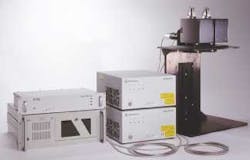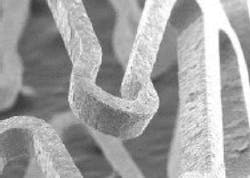During the late 1980s, researchers at Polaroid Corp. (Cambridge, MA) and at the University of Southampton (Southampton, UK) developed clad pumped fiber lasers. In these devices a glass layer surrounding the core fiber serves both as cladding for confining the laser light to the doped single-mode core and as a multimode conduit for pump light propagation within an outer low-refractive-index polymer cladding. These fibers are designed such that, instead of coupling single-mode pump-laser energy directly into the single-mode core of the fiber, the beam from higher-power, multimode diode lasers can be coupled into the glass-cladding layer.
Today fiber lasers use several-meter-long double-clad optical fibers together with an assembly of highly reliable multimode single-emitter diodes providing the pump light into the outer cladding. These single stripe diodes with lifetimes 10 to 100 times that of diode bars are key to high reliability and maintenance-free operation. Current pump diodes based on the same high-reliability design, used in telecommunications products, show tested MTBF values of more than 200,000 hours at 5 W and 25° C ambient temperature. Therefore, fiber lasers offer distinct benefits when compared to more conventional single-mode (TEM00) laser sources of equivalent power, particularly for industrial applications. The benefits include higher wall-plug efficiency, compact design, easy-to-integrate beam delivery and cooler and maintenance-free operation while providing hands-off product lifetime of more than 10,000 hours beam-on time.
Fiber lasers use one percent of the electrical power of an arc lamp-pumped laser and have more than twice the efficiency of a Neodymium-based DPSS system. Higher efficiency, longer lifetime and lower maintenance combine to make the cost of ownership of the fiber laser much more attractive. Fiber lasers are useful in applications that require a rugged source of near-infrared laser light with good beam quality. They should be of particular interest for applications that need a small focused spot and high power density, such as desktop manufacturing. An output beam of 100 W can be focused to diameters as small as 5 microns with corresponding brightness of more than 109 W/cm2. Current applications addressed by fiber lasers include annealing, bending of micro-mechanical components, cutting of 1- to 2-mil stainless-steel parts, selective soldering, marking and various graphic arts applications.
Laser marking
Fiber laser-based marking systems require small floor space and have very low maintenance requirements. The excellent mode quality of fiber lasers is especially useful in high precision marking applications. Single-mode fibers with attached termination modules for beam collimation and integrated zoom optics provide an easy-to-integrate beam delivery over a distance of up to 7 m.
A fiber laser-marking system may consist of one or two fiber lasers with a laser power of up to 25 W each, one or two scan heads to direct the beam onto the samples and an industrial PC to control lasers and scan heads (see Figure 1). This arrangement allows for up to four times higher throughput than dual-head marking with one 50W laser source split into two scanner heads. The maximum marking field size is 175 × 295 mm with a spot size of 35 µm and an absolute positioning accuracy of ±100 µm over the entire marking field. The focal spot size on the work piece surface for the 100-mm work distance is as small as 15 µm. The built-in manual zoom optics allows the spot size to be increased up to 150 µm if needed, without moving the part or scan heads.
Fiber laser material processing is based on thermal processing of the sample, with material absorbing the laser energy and heated locally. The 1-µm wavelength is absorbed by metals, plastics and ceramics.
Figure 2 shows a data matrix code and a logo engraved into a stainless steel surface at a marking speed of 150 mm/sec using a 25W laser. Thin stainless steel foil can be marked at a speed of 750 mm/sec using 15 W of power. Anodized aluminum shows very high contrasts with marking power at 25 W, as the laser energy "blasts" away just a thin layer of colored coating to expose the blank metal underneath.Another application of a precise layer removal by the intense laser energy is the marking of back illuminated knobs and buttons for car dashboards or electronic keyboards. Here the high focusability allows for a very precise material removal of the cover layer.
A fiber laser marking system makes no intrusive marks using the continuous wave (CW) operating mode as opposed to the non-uniform marks of typical pulsed (Q-switched) lamp-pumped or DPSS laser systems. This is important for marking semiconductor packages that have a thin layer of molding compound over the die and wire bonds. The Q-switched laser may produce a non-uniform mark depth and, because of the high energy and short pulsewidth of traditional Q-switched lasers, the mark may vary and strain may be introduced. This strain may cause micro fracturing that will compromise the life and performance of the marked component. With the CW fiber laser, the mark is uniform and virtually strain-free.
Laser bending
Fiber laser bending or forming is a technique to modify the curvature of sheet metal or hard ceramic. Localized heating and rapid self-cooling cause plastic deformation in the laser-heated area, permanently changing the curvature of the target. Studies1 show that micro-bending with lasers produces precision greater than other methods, and therefore it is an ideal method for applications in microelectronics fabrication.
CW fiber lasers prove to be high-performance and reliable tools in 24/7 manufacturing environments in the hard-disk drive industry to precisely bend semiconductors, ceramics and metal components. Several hundred fiber lasers are installed in this industry. The precise and controllable fiber laser beam satisfies the disk drive manufacturers' need for ways to create more accurate and repeatable bends in continuously smaller devices. Other benefits include the fact that there are no wearing parts or consumables in this laser manufacturing process, as well as minimal operator involvement.
Laser cutting
In the medical device industry there is a great demand for laser micro-cutting. Flashlamp-pumped solid-state lasers, currently used for this application, operate near their diffraction-limited beam performance to maintain a very small kerf width. To meet yields and up-time requirements in this industry reliable laser operation and low maintenance are required. It is a challenge to keep such a laser system performing with the consistency required under production conditions.2 The fiber laser concept offers benefits to maintain high up-time and high yields. The single-mode fiber laser does not need mirror alignment and has low maintenance, because flashlamp changes are eliminated. The compact air-cooled design saves expensive cleanroom space.
Recent improvements in average laser power now make the fiber laser suitable for industrial cutting applications. For example, micro-cutting of stainless steel stents with fast-gated CW fiber lasers shows this unit is an excellent tool for micro-cutting. Simple triggering of the pump diodes allows gating up to frequencies of 3,000 Hz for the cutting experiments. Due to its good beam quality, fiber lasers are able to achieve very small focus diameters and therefore small cutting kerf widths in process setups standard in today's medical device industry. The cuts produced by CW fiber lasers show very similar features to those reported with conventionally used lasers3 (see Figure 3).Conclusion
The fiber laser, a compact, air-cooled, "plug and play" component, fits into almost any manufacturing line and is designed to last many years without replacement or any maintenance. High beam focusability provides very high power densities at useful working distances allowing for a wide range of applications.
A most exciting prospect for these lasers, however, is a significant cost reduction resulting from the inherent simplicity and modularity of today's fiber laser concepts. As volume markets develop and manufacturing processes are streamlined, the manufacturing costs of both semiconductor pump lasers and optical fiber assembly should drop, lowering the cost of fiber lasers as compared to equivalent conventional systems.
References
- R. Zhang, X. Xu, "Micro Bending using Pulsed and CW Lasers," Proceedings of LASE 2001, San Jose, Jan. 2001.
- K.F. Kleine, B. Whitney, K.G. Watkins, "Use of Fiber Lasers for Micro Cutting Applications in the Medical Device Industry," Proc. of Laser Institute of America, ICALEO 2002, Laser Microfabrication Conference, Scottsdale, AZ, 2002.
About the Author
Ruediger Hack
Vice President Sales and Marketing, Bruker Nano Analytics
Dr. Ruediger Hack is vice president of sales and marketing at Bruker Nano Analytics (Berlin, Germany area). From 2004 through 2008, he served as worldwide director of sales at Coherent (Munich, Germany area).


